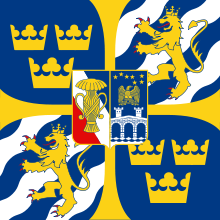- Coat of arms of Sweden
-
Coat of arms of Sweden 
Versions 
The lesser coat of arms of Sweden, as used by the GovernmentDetails Armiger Carl XVI Gustaf Adopted April 11, 1525
November 17, 1905Crest Royal Crown of Sweden Escutcheon Azure, quartered by a cross Or with outbent arms, and an inescutcheon containing the dynastic arms of the Royal House. In the first and fourth fields three open crowns Or, placed two above one. In the second and third fields three sinisterbendwise streams argent, a lion crowned with an open crown Or armed gules. The inescutcheon is party per pale the arms for the House of Vasa (Bendwise azure, argent and gules, a vasa (sheaf of wheat) Or); and the House of Bernadotte (Azure, issuant from a wavy base a bridge with three arches and two towers embattled argent, in honor point an eagle regardant with wings inverted resting on thunderbolts Or, and in chief the Big Dipper constellation of the same). The main shield is crowned by a royal crown and surrounded by the insignia of the Order of the Seraphim. Supporters two lions regardant, crowned and with forked tails (queue fourchée) Or armed gules, standing on a compartment Or Orders Order of Seraphim Other elements All surrounded by ermine mantling, crowned with a royal crown and tied up with tasseladorned strings Or The greater national coat of arms (stora riksvapnet) and the lesser national coat of arms (lilla riksvapnet) are the official coats of arms of Sweden.
Contents
Description
Escutcheon
The escutcheon used in the greater blazon has in total five elements: 4 quarterings on the main escutcheon (two coats of arms duplicated), and three coat of arms incorporated into a escutcheon of pretense. However, Bernadotte never used any stars in the arms of Pontecorvo (neither as Prince of Pontecorvo, nor as King of Sweden and Norway) contrary to the illustration below. The stars were introduced as an element in the royal coat of arms in mid 19th century and then above the eagle.[1]
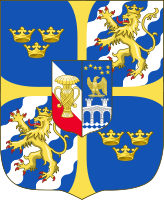
↗ ↗ ↖ 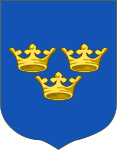
The three crowns
Coat of arms of the House of Bjelbo
Coat of arms of the House of Bernadotte↗ ↖ 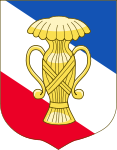
Coat of arms of the House of Vasa
The initial coat of arms of the Jean-Baptiste Jules Bernadotte, Prince de Ponte Corvo, Maréchal de France (later King Charles XIV John of Sweden)↑
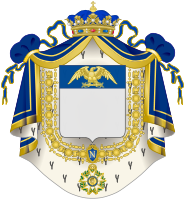
Standard quartering for the sovereign princes under the Napoleon I of the First French Empire.↑

Eagle emblem of Napoleon ISupporters
The arms are supported by two lions with forked tails (queue fourchée), facing away from the shield and crowned with Royal Crowns. For centuries, the lion has been an important element in Swedish heraldry and especially for the State Coat of Arms.
Collars of the Royal Orders
The shield may be surmounted by the Collar of the Order of Seraphim, the foremost order in Sweden, and the highest honour the Swedish state can bestow on an individual.[2]
General description
Besides being the official national coat of arms, the greater coat of arms is also the personal coat of arms of the king, and as such he can decree its use as a personal coat of arms by other members of the Royal House, with the alterations and additions decided by him.
Blazon: "The greater state arms consist of a head shield azure, quartered by a cross or with outbent arms, and an inescutcheon containing the dynastic arms of the Royal House.
In the first and fourth fields three coronets or, placed two above one. In the second and third fields three sinisterbendwise streams argent, a lion crowned with an open crown or with armaments gules. The inescutcheon is party per pale the arms for the House of Vasa and the House of Bernadotte. The main shield is crowned by a royal crown and surrounded by the insignia of the Order of the Seraphim. Supported by two lions regardant or crowned, with parted tails and armaments gules, standing on a postament. All surrounded by hermine mantling crowned with a royal crown and tied up with tasseled strings or."
Personal Command Sign of H.M. the King
The Personal Command Sign of H.M. the King of Sweden was introduced by a Royal regulation in 1943. The Command sign includes the central part of the greater coat of arms. The banner, officially termed His Majesty's Personal Command Banner, is one of a kind. The only copy was created by Einar Kedja, a renowned Swedish heraldic artist. The cloth is permanently attached to a pole with a crown serving as finial.
The lesser coat of arms
The lesser coat of arms is mainly used by the Government of Sweden and its agencies. As such it may be joined by insignias symbolising their activity, following approval by the State Board of Heraldry. It is, for instance, embroidered on all Swedish police uniforms.
Blazon: "Azure, with three coronets Or, ordered two above one." Crowned with a royal crown. The shield may also be surrounded by the insignias of the Order of the Seraphim."
Regulated usage
The usage of the coats of arms is regulated by Swedish Law, Act 1970:498, which states (in translation) that "in commercial activities, the coats of arms, the flag or other official insignia of Sweden may not be used in a trademark or other insignias for products or services without proper authorisation. This includes any mark or text referring to the Swedish government which thus can give the commercial mark a sign of official endorsement. This includes municipal coats of arms which are registered."
Any representation consisting of three crowns ordered two above one are considered to be the lesser coat of arms, and its usage is therefore restricted by law 1970:498.
References
- ^ Arvid Berghman: Dynastien Bernadottes vapen och det svenska riksvapnet (Stockholm : Svensk litteratur, 1944)
- ^ See sections 2 and 3, Lag No. 268 om Sveriges Riksvapen of April 29, 1982.
See also
Links to related articles  National symbols of Sweden
National symbols of SwedenNational flag · Coat of arms · National anthem · Three Crowns · Mother Svea
Coats of arms of Europe Sovereign
states- Albania
- Andorra
- Armenia
- Austria
- Azerbaijan
- Belarus
- Belgium
- Bosnia and Herzegovina
- Bulgaria
- Croatia
- Cyprus
- Czech Republic
- Denmark
- Estonia
- Finland
- France
- Georgia
- Germany
- Greece
- Hungary
- Iceland
- Ireland
- Italy
- Kazakhstan
- Latvia
- Liechtenstein
- Lithuania
- Luxembourg
- Macedonia
- Malta
- Moldova
- Monaco
- Montenegro
- Netherlands
- Norway
- Poland
- Portugal
- Romania
- Russia
- San Marino
- Serbia
- Slovakia
- Slovenia
- Spain
- Sweden
- Switzerland
- Turkey
- Ukraine
- United Kingdom
- (England
- Northern Ireland
- Scotland
- Wales)
- Vatican City
States with limited
recognition- Abkhazia
- Kosovo
- Nagorno-Karabakh
- Northern Cyprus
- South Ossetia
- Transnistria
Dependencies
and other territories- Åland
- Faroe Islands
- Gibraltar
- Guernsey
- Jan Mayen
- Jersey
- Isle of Man
- Svalbard
Other entities Categories:- National coats of arms
- National symbols of Sweden
- Personal flags
- Swedish coats of arms
Wikimedia Foundation. 2010.

